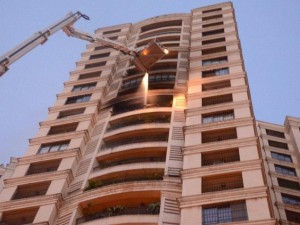Make High rises a Safe Haven!
In view of the recent Fire at Chandivali Highrise on Saturday, Masters hard presses on SAFETY FIRST yet again. Fire protection engineers must be involved in all aspects of the design in order to ensure a reasonable degree of protection of human life from fire.
Highrises or any construction project need to be designed to incorporate efficient, cost-effective passive and automatic fire protection systems. These systems are effective in detecting, containing, and controlling and/or extinguishing a fire event in the early stages.

Fire protection engineers must be involved in all aspects of the design in order to ensure a reasonable degree of protection of human life from fire and the products of combustion as well as to reduce the potential loss from fire (i.e., real and personal property, information, organizational operations).
Planning for fire protection in/around a building involves knowing the four sources of fire: natural, manmade, wildfire and incidental and taking an integrated systems approach that enables the designer to analyze all of the building's components as a total building fire safety system package. The analysis requires more than code compliance or meeting the minimum legal responsibilities for protecting a building; that is, building and fire codes are intended to protect against loss of life and limit fire impact on the community and do not necessarily protect the mission or assets, or solve problems brought upon by new projects with unique circumstances.
Therefore, it is necessary to creatively and efficiently integrate code requirements with other fire safety measures as well as other design strategies to achieve a balanced design that will provide the desired levels of safety (evacuation, recovery, egress/smoke. Identify critical systems: diesel generators, etc.).
RECOMMENDATIONS
Issues to address in developing a successful fire protection design usually include:
Design Team—It is most important that the project delivery team include a Fire Protection Engineer with adequate experience and knowledge in fire protection and life safety design. The Fire Protection Engineer should be involved in all phases of design, from planning to occupancy.
Design Standards and Criteria (i.e., Building Code, etc.)—to be utilized by the design team, including statutory requirements, voluntary requirements addressing owner's performance needs, and requirements that are sometimes imposed by insurance carriers on commercial projects.
Site Requirements—A quality site design will integrate performance requirements associated with fire department access, suppression, and separation distances and site/building security.
- Design buildings with uncomplicated layouts that enable firefighters to locate an area quickly.
- Provide rapid access to various features such as fire department connections (FDCs), hose valves, elevators and stairs, annunciators, key boxes, etc.
- Accommodate the access of fire apparatus into and around the building site


